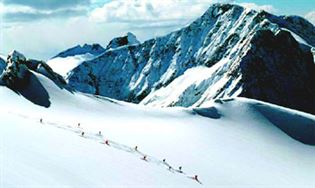 Helicopters stood in silence, flags fluttered and people milled about on the broad plateau beneath Saddle Mountain, chatting or munching smoked salmon and other treats from a vast buffet spread on improvised tables carved from the compact spring snow. Mike Wiegele stood in the stiff April breeze and officially announced that Saddle Mountain Resort had received the crucial provincial approval it needed to go forward. It was an emotionally charged moment for Wiegele, one of heli-skiing’s three original founders.
Helicopters stood in silence, flags fluttered and people milled about on the broad plateau beneath Saddle Mountain, chatting or munching smoked salmon and other treats from a vast buffet spread on improvised tables carved from the compact spring snow. Mike Wiegele stood in the stiff April breeze and officially announced that Saddle Mountain Resort had received the crucial provincial approval it needed to go forward. It was an emotionally charged moment for Wiegele, one of heli-skiing’s three original founders.
Wiegele took a lengthy pause while all the feelings flooded over him. His guides, staff and the assembled government officials understood what this meant—the boldness of the vision, the future possibilities, but also the risks Wiegele was embracing at a point in his career when many others would be content to relax on the porch. But some of the heli-skiing guests seemed oblivious to the implications.
“This is about creating the picture-perfect skiing place—the world’s best,” said Wiegele during a lengthy interview months later—just a few weeks ago, actually. “We’ve got eight big peaks available, with consistent, reliable powder from November through May, which gives us the potential. The village will be central within the eight peaks.”
This is a major departure for the skiing industry. Its backcountry portions—heli-skiing, snowcat skiing and touring huts—mostly exist as a separate world from lift-serviced resorts. True, it’s not completely unknown for a major resort to offer snowcat or heli-skiing as an exotic extra, appreciated by few—conceptually akin to add-ons like dogsledding or wildlife viewing. Only one resort I know of, the new development at Revelstoke, is making a point of integrating snowcat and heli-skiing with its lift-based core. Wiegele’s stands alone as the sole heli-skiing operation that will build its own ski resort.
So the chief driver evolved from the local community to Wiegele’s own clientele. Heliskiing is undergoing an extended, challenging transition. This heretofore elite industry, whose operators were accustomed to being fully booked one, two and even three seasons forward, seemingly regardless of economic cycles or price increases, quite suddenly found itself scrambling to ? ll tours. Steady increases in industry capacity, combined with an unforeseen and still unexplained decline in overall guest traffic beginning in about 2003, altered the supply-demand balance. Nobody knows if it’s short- or long-term. But everyone accepts that the clientele is getting older and skiing less intensely. The fat ski revolution of the ’90s had enabled older clients to continue and less-fit skiers to enter the sport. It was hugely beneficial, but basically a one-time step-up.
With Saddle Mountain, Wiegele aims to alter the whole experience of heli-skiing. “We’re not building for masses, but for membership—we don’t need huge capacity,” he says. “We want to create a good, healthy culture that is selfsupporting.” The resort will be based on a clientele membership, some of whom could also be investors. There’s still a lot to ? gure out. Will the skiing slopes even be open to the general public, for example? Either way, it must be something unique, says Wiegele, “Because the conventional local ski area is not a viable business model. Even big areas don’t really make money on operations. We need to create a viable business.”
Thinking about it in my own way, I realized Saddle Mountain could replace the whole quiver of adjectives that go with heli-skiing. Typical words now are awesome, gnarly, huge, steep ’n’ deep, unbelievable, fast-paced, phenomenal, longest runs, most vertical—but also risky, unforgiving, stressful, competitive and arrogant. The best of these would certainly remain for the committed, hardcore heli-skier—the Cariboo and Monashee mountains aren’t going anywhere. But the new village will create new mental images, Wiegele hopes: welcoming, congenial, reassuring, nurturing, joyful. This should appeal to a much broader spectrum of skiers, plus nonskiers seeking the mountain lifestyle.
We won’t see much infrastructure sprouting right away. Wiegele is intent on initially getting the skiing right. The ? rst of up to eight lifts, plus a small lodge and staff accommodations, isn’t due until 2010—and this will be a short lift on flat terrain for children of guests and staff, plus first-timers or older skiers warming up for the helicopter. Meanwhile, glading and run-cutting will continue, and the eight peaks will get skied more and more by snowcat and helicopter. If he can make skiers happy, Wiegele feels, they’ll naturally want to build houses. From that would eventually come a year-round village with every conceivable feature.
“Here’s what differentiates us from anybody else,” says Wiegele. “We’re going to build nice places, but we’re not going to BS people about what the skiing might be like. We’re going to start with the skiing, and then we’re going to build. People can compare it to every other potential skiing offer around the world. Then they can come here and build whatever they want—a $5-million house on several acres or a modest cabin.”
It’s often been claimed there’s a basic divide between North American and European thinking: one demands instant gratfication, while the other seeks achievements for the ages. Born into a rural Austrian family but making a lifelong commitment to Canada, Mike Wiegele has made a career out of providing both.



